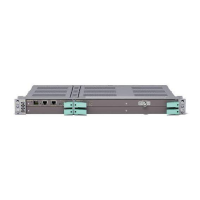Radio Terminals
4.3.4.2 Transmit IF Signal Processing
The input amplifier is automatically gain-controlled so that no compensation is
required due to the cable length between the indoor and outdoor equipment.
The level is used to generate an alarm, indicating that the transmit IF signal
level is too low due to excessive cable losses.
4.3.4.3 Transmit IF Demodulator
The transmit IF signal is amplified, limited and demodulated. The demodulated
signal is fed to the Transmit RF Oscillator onto the RF carrier.
4.3.4.4 Transmit IF Oscillator
The frequency of the transmitter is controlled in a Phase Locked Loop (PLL),
including a Voltage Control Oscillator (VCO). An unlocked VCO loop generates
a transmitter frequency alarm.
4.3.4.5 Up-converter 1
The first up-converter gives an IF signal of approximately 2 GHz.
4.3.4.6 Filter and Amplifier
The converted signal is amplified and fed through a bandpass filter.
4.3.4.7 Transmit RF Oscillator
This oscillator is implemented in the same way as the Transmit IF Oscillator.
4.3.4.8 Up-converter 2
The transmit IF signal is amplified and up-converted to the selected radio
transmit frequency.
4.3.4.9 Power Amplifier
The transmitter output power is controlled by adjustment of the gain in the
Power Amplifier. The output power is set in steps of 1 dB from the LCT. It is
also possible to turn the transmitter on or off utilizing the Power Amplifier.
The output power signal level is monitored enabling an output power alarm.
4.3.4.10 RF Loop
The RF Loop is used for test purposes only. When the loop is set, the
transmitter frequency is set to receiver frequency and the transmitted signal in
the Branching Filter is transferred to the receiving side.
73
4/1555-CSH 109 32/1-V1 Uen B 2007-09-14

